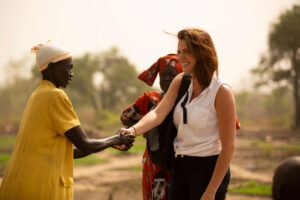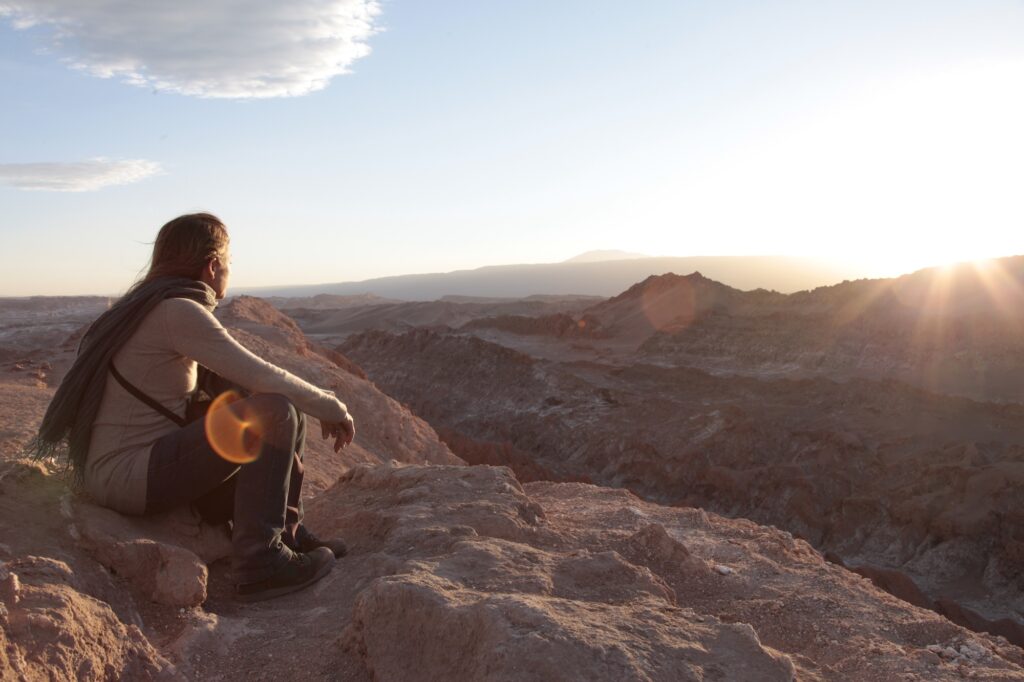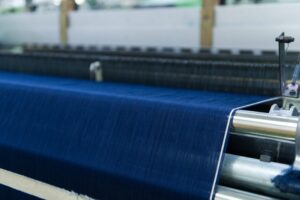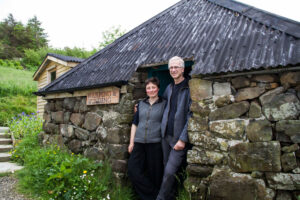
Obakki – A Purpose-Led Lifestyle Brand and Foundation
Founder Treana Peake, supports artisan partnerships and funds development work through the Obakki Foundation.
Italy
Mood of Living January 10, 2017
From her first job researching fashion trends for knitwear companies in Tuscany, Italy, Barbara Guarducci’s involvement in and contribution to the fashion textile industry has been exceptional. Originally from the Tuscan textile city of Prato, she graduated from the Polimoda fashion school in Florence with a degree in textile design and production and immediately dove into the design world as a costume designer for theater and cinema.
Barbara went on to become an accessories designer and creative director, working with creative minds who taught her how to use her own creativity to transform concepts into a visual world and into products. She got involved with sustainability and the need to support local craft in the textile industry early on in her career, creating a luxury brand that was about upcycling vintage clothes and textiles to create unique pieces crafted and made completely in Italy- which at that time was a very experimental concept. But while many people would be happy to stop there and enjoy their success, Barbara saw an opportunity to take her passion to another level by incorporating philanthropy. She got her first taste of international cooperation design via a collaboration with the United Nations in 2003 and never looked back.
Today, she oversees design projects that combine social value with beauty and works with artisans from all over the world. Influenced by the growing fragility of her home country of Italy and the disappearance of craft, she works with Fondazione Zegna as creative director of the San Patrignano hand-weaving workshop, which acts as a drug rehabilitation community offering young people a home and the chance to learn professional craftsmanship. For Barbara, social empowerment and highly skilled craft are not mutually exclusive.
Mood of Living: What inspired you to change career direction from a costume designer for theater and cinema to becoming a textile designer?
Barbara Guarducci: Actually I have been working in both fields at the same time for 10 years, enjoying both and enriching my knowledge by experimenting with different approaches to creative thinking: one with the challenge of the market, the other to create a visual dream. I decided to quit costume design after having had some experience in cinema, which was beautiful but very demanding in terms of private life. I realized that was not my path and chose to be nearer to my son, who was really young at the time, and came up with a new idea for myself by creating my own accessories brand named SOTO in 2000.
MoL: Where do you look for inspiration?
B.G: Inspiration comes to me from everywhere. I am usually very inspired by contemporary art as well as by nature. Sometimes it is raw materials themselves that inspire me and activate my imagination. Basically I look with curiosity at all aspects of life and get inspired by the most unusual details.
MoL: You say you had a “calling” to turn your attention back to your homeland of Tuscany; how did the project you are currently invested in, San Patrignano, unfold?
B.G: In 2012 I was contacted by Fondazione Zegna to get involved as creative director in the hand weaving workshop of San Patrignano, a drug rehabilitation community in Italy where young people are offered a home, a family and the opportunity to learn a professional craftsmanship training. As creative director, I organize the working methods, design the textile collection, present it to the market, and follow private label development. All this work was of course supported by an incredible team on the production and marketing sides, making possible the success we have encountered. The social aspect is always at the forefront of our decisions, and that is why we have involved the 40 girls who are part of the community and work in the textile sector in the process of organization, creation of the collections, and relationship with the clients. Their involvement has been the most satisfying result of the project, and now they work with passion and discipline. This is a precious achievement for their healing process.
At the same time, the sector had to become self-sustainable, and our goal was a relationship with the mainstream fashion market. We have built working relationships with major brands and designers, and have built strong relationships with interior designers and architects worldwide for whom we create handwoven home textiles and upholstery for private projects.
MoL: With the end goal of providing a born-again purpose to the young people within the San Patrignano community, what do you see as the future for the foundation and the lives of those involved?
B.G: I can speak for the textile sector and the goals we wish to achieve in 2017. With the project on track, where the sector is growing and has become self sustainable, we are now focusing on the future of the girls working with us. We train young, talented and passionate artisans that could preserve precious craft skills and prevent their disappearance! We are providing specialized training for them and we are organizing a network with the industry to create opportunities for those willing to continue working in textiles and fashion.
MoL: What is your biggest joy that comes from collaborating, leading, and being involved in these projects?
B.G: Witnessing the growth and empowerment of the people involved in these projects. Through the creation of real working relationships with the fashion or the design sectors, I connect worlds that would rarely otherwise meet. Witnessing these strange meetings and unusual relationships begin to flower makes me extremely happy! I see myself simply as a translator; meaning that I translate amazing craft skills that already exist into original products that are marketable and pleasant. I help the people to look beyond their craft knowledge and try new paths that involve design and creativity.
MoL: What other projects exist in the San Patrignano community?
B.G: The community of San Patrignano is based on a professional training and schooling setup, following the belief that this approach is both educational and therapeutic. Learning a profession means growing in self-esteem and interpersonal relationships; it is also the key to full reintegration into society. The community is divided into many different sectors. We have everything from a craft area where people work in weaving, wallpaper painting, leather goods making, carpentry, graphic design, printing, and video making to various agricultural activities such as livestock farming and food processing dairy, baked goods, and wine. This makes a total of around 50 different sectors in the community and a total of around 1500 people involved.
MoL: Tell us about the refugee project you’re organizing.
B.G: I am finalizing the organization of a professional training in knitwear for refugees and people in need here in Tuscany that will be launched at the beginning of 2017. It is a very ambitious project done with a local cooperative named Manusa. This group of passionate human beings work with textiles as a tool to give value to local craft know-how and to the lives of those involved in their projects. The idea comes from the fact that knitwear technical knowledge is a disappearing craft and that there is an industry in Italy that is actually looking for skilled workers. This is our target and our ambition: to create skilled people, preserve a beautiful craft know-how, and create job opportunities for all those in need.
MoL: Since you got your start in the world’s second largest industry culprit of global damage, how have you seen the term “sustainability” shift and grow in fashion?
B.G: From the eco trends of the 1990s, which were the first attempts at a new and upcoming green culture in textiles, we have now got to a point where sustainability has become an unavoidable choice for the whole fashion system. That means environmentally friendly choices in the production process, respect for human rights, and transparent information on products given to the final customer are pertinent. All this should be everyday practice, but we still cannot take transparency and green choices in the fashion industry for granted. We need to fight for a totally new model that holds its success in the technological research and smart solutions of the textile industry to reduce waste and pollution, in educating consumers to demand transparency, and in eradicating human exploitation.
MoL: Africa has been at the forefront for luxury sustainability with companies such as Edun and Studio189 – do you see this trend continuing or do you believe there is a different region soon to be in the spotlight?
B.G: The two experiences you mention have been important for creating a trend and have showed a new way of behavior for the industry. It’s a new way of sourcing textiles and making fashion where the social aspect is as important as the business. There are other beautiful experiences that take place in many African countries and there are amazing ones involving other countries all over the world as well. I would like to get to the point where sustainable sourcing will be mandatory and can be done anywhere in the world.
MoL: Being familiar with the raw documentary The True Cost (which strips down the barriers between consumers and the fashion industry and removes any naiveté about damage done to our Earth) what are your thoughts on the world of fast fashion?
B.G: Even the term ‘fast fashion’ sounds wrong, this bulimic way of proposing that fashion is not fun anymore. There is a need to be realistic and to analyze this winning phenomenon and to be able to give new, unexpected answers to an undoubtedly spoiled market. It is an intricate issue and in my opinion, there are multiple goals that need to be pursued.
First of all, we need to educate the final consumers by making them aware that their purchasing choices impact someone on the other side of the world. We also need the whole production chain to make a clear stand on rules and regulation both on the environmental and the human rights sides. I believe that the ‘fashion revolution’ movement is doing a great job in educating people about asking the fast fashion system to change. Major changes will occur only through real political support on all these issues, strict international rules on textiles, and wider transparent communication; it will take time to change and transform but it is a process that has already started. In my own experience, I show the documentary whenever I can but at the same time I talk about the positive experiences I have witnessed and how a way out from this hypocritical system is possible!
MoL: Based on your travel and experiences, how do you think America and other countries are responding and catching on to this conscious lifestyle?
B.G: Big steps have been taken and the possibility for choosing sustainably sourced products is easier and more accessible, not only within niche markets. But there is still a long way to go! In the U.S. I see a big gap between the super-conscious and the average mass consumer; it is like two opposite worlds living side by side. There is a need to educate end users and give them the tools to become critical about their purchases. The question is if mainstream fashion wants that.
MoL: Of all the places you have traveled to, what place or experience has stuck with you the deepest?
B.G: Ethiopia is the country that is most deeply rooted in my heart: Maybe it is because I moved there with my son Lorenzo when he was 11; he studied there for a year while I was working on a UNIDO project. What was meant to be a professional experience has become a true life experience that deeply changed me and my son forever.
MoL: What is your best piece of advice for those aware (or not) of the sustainability movement and how to positively impact the world? How do we voice this calling?
B.G: By becoming a critical consumer in the first place: buy less and buy better quality products, do not throw things away, mend and upcycle waste products, ask where things come from. This applies to whatever sector we talk about: fashion, design, food, health, etc.
MoL: What is the most valuable piece of knowledge you have taken away from your experiences?
B.G: Humility in relationships with people and an open perception are the most important things when you work with different cultures and people with various backgrounds. Each culture has a beauty, and an open mind is necessary to welcome differences and translate them through a creative process. I am asked to share my professionalism and amazingly I always learn so much and come back home with a new gift to share.
MoL: What is a favorite craft skill of yours you have witnessed, taught or worked with?
B.G: I have many favorite crafts: I absolutely love hand weaving; the slow and rhythmic pace needs a concentration that is close to meditation, and the conceptual aspect of two yarns woven together to create a design is very poetic to me. Basketry is another craft that I adore and practice in my free time. Embroidery is a skill I never stop learning about!
MoL: What is your biggest triumph?
B.G: Having never given up on my intellectual freedom.
MoL: Where do you see your journey going in the next few years, and what is a future goal on the horizon you hope to accomplish?
B.G: I wish to continue pursuing my dream of giving voice to those small or marginalized entities. They have unique craft knowledge or skills that can be translated into beautiful products that can be loved by the mainstream market. Through these products we tell a story and show the humanity behind the making process. The social impact of the projects I am involved with is an essential ingredient in my professional choices.

Guarducci in the Valle de la Luna, Chile.
MoL: Language is one of the dividing forces in this world. How do you overcome those barriers? What languages do you speak?
B.G: I speak Italian, English, and French, and I can go anywhere with those. In Spanish-speaking countries I can communicate in Italian.
MoL: What music inspires you?
B.G: I always have a very precise routine. I need total silence when I am at the beginning of a creative project, I listen to classical music while developing the project and I can listen to any kind of music when the process is on track.
MoL: What gets you out of bed every morning to continue this journey of cultural preservation?
B.G: The belief that I am witnessing a revolution in the system, and I am an active actor of the change that is occurring. We are going through a social transformation where honest quality will be at the core of design and I find that very exciting!
MoL: When are you happiest?
B.G: I am happy when I feel that I am flowing with the universe and everything is in its right place.
MoL: What does quality of life mean to you?
B.G: Living surrounded by nature.
Photography courtesy by Barbara Guarducci

Founder Treana Peake, supports artisan partnerships and funds development work through the Obakki Foundation.

Tatsushi Kuroki has made a career of infusing sustainability into the denim production process.

Andrea and Roger Holden traded in their agricultural lifestyle to set up a textile company in Scotland.